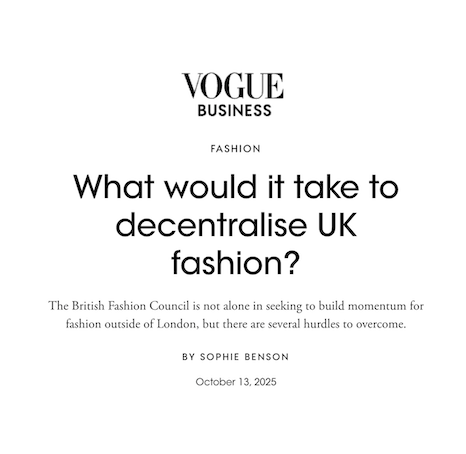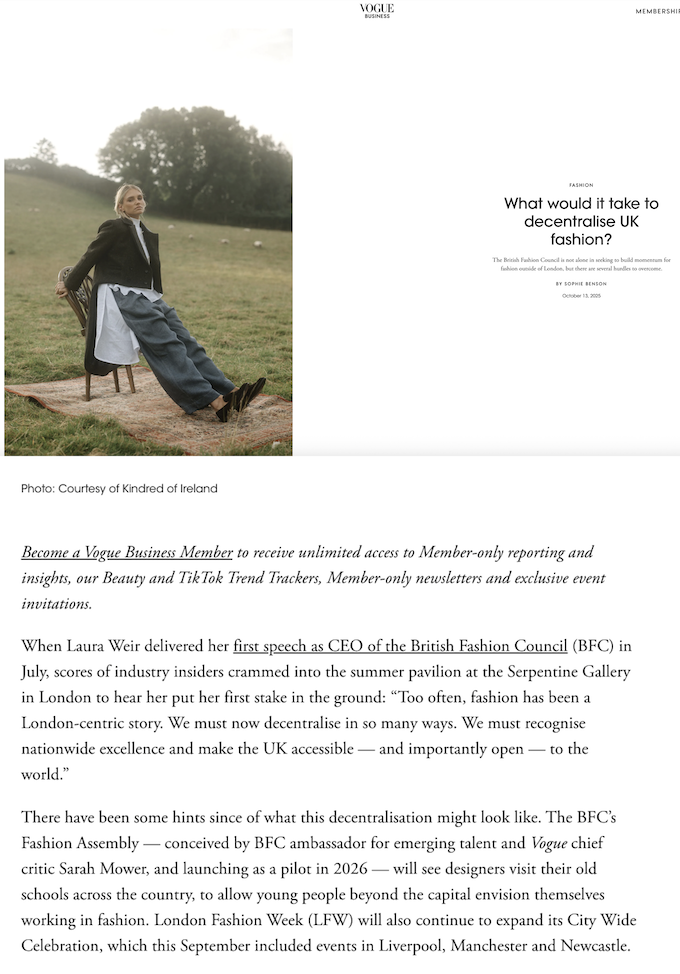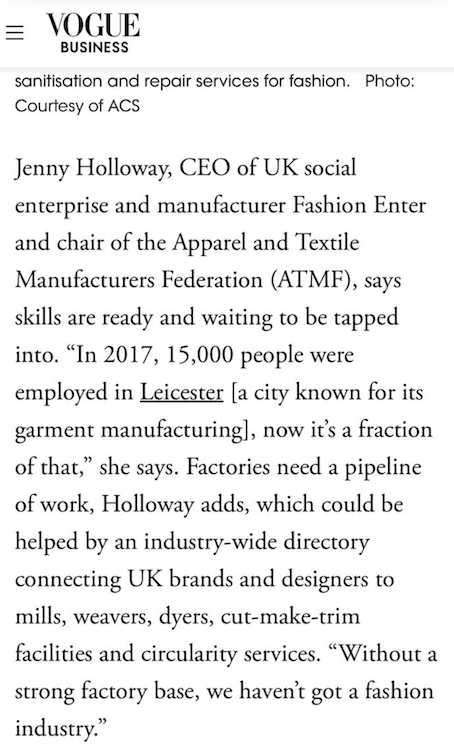Vogue Business: What would it take to decentralise UK fashion? Asks Sophie Benson

14-10-2025
In the recent Vogue Business article titled “What would it take to decentralise UK fashion?” Compiled by Sophie Benson, 13th October 2025, the British Fashion Council (BFC)’s vision for a more geographically inclusive fashion industry was brought into sharper focus. With initiatives like the Fashion Assembly and London Fashion Week’s expanding City Wide Celebration reaching beyond the M25, the conversation around decentralising UK fashion is gaining momentum. But as industry voices like Jenny Holloway, CEO of Fashion-Enter Ltd and Chair of the Apparel and Textile Manufacturers Federation (ATMF), rightly point out, inclusion cannot begin and end with visibility, it must also mean investment, infrastructure, and sustained commitment to regional skills.

(The Vogue Business article by Sophie Benson)
“Without a strong factory base, we haven’t got a fashion industry,” Holloway states plainly in the article. It’s a sobering truth. Her comments reference Leicester, once a thriving hub of garment production in the UK. In 2017, the city employed 15,000 people in fashion manufacturing. Today, that number has drastically shrunk, not due to a lack of skills or heritage, but because of the erosion of consistent work, the lifeblood of any supply chain.
The Midlands, Yorkshire, and parts of the North have long been homes to expert weavers, dyers, seamstresses and cutters – a deeply embedded network of talent and technical expertise. These are not new skills being introduced, but generational crafts at risk of extinction. Holloway highlights the urgency: the skills base is already there, but without a steady pipeline of orders and long-term commitment from UK brands, factories cannot survive.
The decentralisation conversation often centres on designers, but as Holloway and other manufacturers stress, fashion isn’t just about what’s seen on the runway. It’s about what happens behind the scenes, the people who make the clothes, the materials they work with, and the systems that enable ethical, traceable, and circular production.
The BFC’s efforts, such as its planned 2026 Fashion Assembly, where designers will visit their former schools to inspire young people, are commendable steps toward creating visibility and aspiration. But visibility alone cannot pay wages or keep factory doors open. What’s urgently needed is a nationwide infrastructure to connect designers and brands with the regional capabilities already in existence: a living, digital directory of UK-based mills, cut-make-trim (CMT) units, textile recyclers and circularity services.
This is precisely the sort of intervention Holloway advocates, practical, grounded, and actionable. Without it, decentralisation risks becoming just another headline.
The article also touches on the broader structural support needed: from policy shifts that drive regional investment, to industry-wide buy-in that ensures decentralisation isn’t just a top-down initiative but a shared goal. While the BFC can play a coordinating role, it cannot be expected to shoulder this transformation alone.
There is an opportunity here, not just to revive the regions, but to redefine what a resilient and ethical British fashion industry looks like. One that values design and production equally, recognises the role of every maker in the supply chain, and ensures that regional skills are not a footnote, but a foundation.
Thank you to Sophie Benson / Vogue Business for including the voice of FEL / ATMF Jenny Holloway.

Tap here to read the full Vogue Business article.























